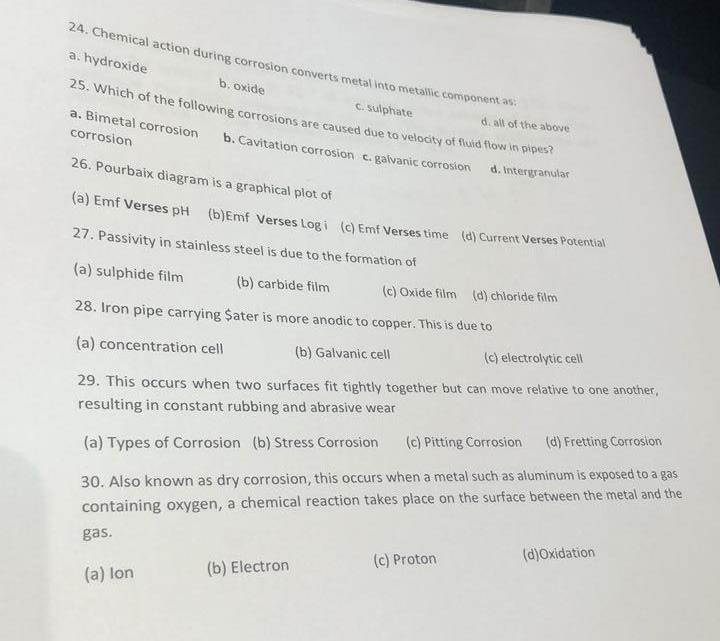Answered step by step
Verified Expert Solution
Question
1 Approved Answer
24. Chemical action during corrosion converts metal into metallic component as: a. hydroxide b. oxide C. sulphate 25. Which of the following corrosions are

24. Chemical action during corrosion converts metal into metallic component as: a. hydroxide b. oxide C. sulphate 25. Which of the following corrosions are caused due to velocity of fluid flow in pipes? d. Intergranular b. Cavitation corrosion c. galvanic corrosion a. Bimetal corrosion corrosion 26. Pourbaix diagram is a graphical plot of (a) Emf Verses pH (b)Emf Verses Logi (c) Emf Verses time (d) Current Verses Potential 27. Passivity in stainless steel is due to the formation of (a) sulphide film (b) carbide film 28. Iron pipe carrying $ater is more anodic to copper. This is due to (a) concentration cell (b) Galvanic cell (c) electrolytic cell 29. This occurs when two surfaces fit tightly together but can move relative to one another, resulting in constant rubbing and abrasive wear (a) Types of Corrosion (b) Stress Corrosion (c) Pitting Corrosion (d) Fretting Corrosion 30. Also known as dry corrosion, this occurs when a metal such as aluminum is exposed to a gas containing oxygen, a chemical reaction takes place on the surface between the metal and the gas. (a) lon (b) Electron d. all of the above (c) Oxide film (d) chloride film (c) Proton (d)Oxidation
Step by Step Solution
★★★★★
3.44 Rating (173 Votes )
There are 3 Steps involved in it
Step: 1
The detailed answer for the above question is provided below 24 Chemical action during corrosion converts metal into metallic component as b Oxide Corrosion is a chemical reaction that converts metal ...
Get Instant Access to Expert-Tailored Solutions
See step-by-step solutions with expert insights and AI powered tools for academic success
Step: 2

Step: 3

Ace Your Homework with AI
Get the answers you need in no time with our AI-driven, step-by-step assistance
Get Started


